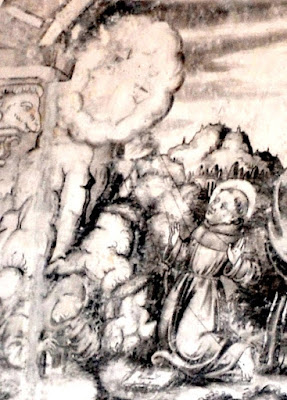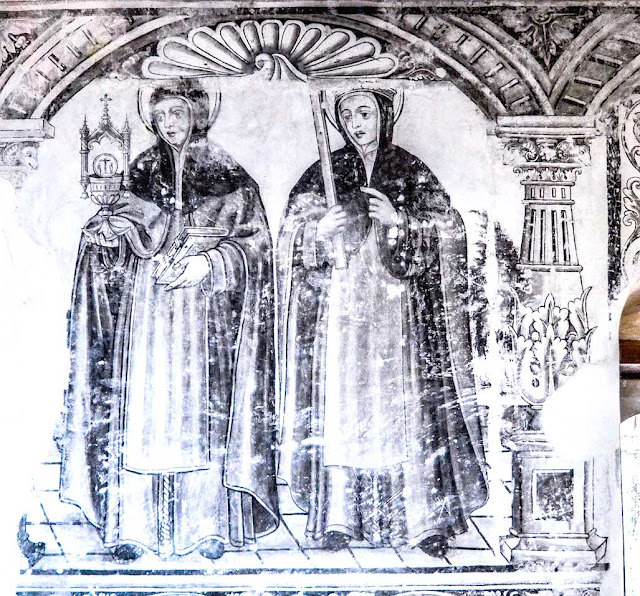The hillside Franciscan monastery of San Juan Bautista Cuautinchán, south of the city of Puebla, is among the most impressive early colonial monuments in Mexico.
Despite several earthquakes, the powerful stone buttresses and the massive, rounded apse of the church have sustained the structure through more than 400 years. The church is perhaps best known for its magnificent early altarpiece, which we have discussed in our sister blog.
 |
| Cuautinchan, the arcaded porteria |
The Convento Murals
Unfortunately, despite its importance, no major mural programs have survived intact at Cuauhtinchán. However, a few fragments of distinctive frescoes do survive in the convento precincts.
Starting in the entry portería, vestiges remain of a once ambitious, polychrome mural portraying several friars and a bishop surrounding an unidentified figure on an elaborate dais—possibly St. Francis as Protector of the Order?
Three Friezes
Inside the convento we focus on three unusual murals, each of which takes the form of a pictorial frieze above a cloister doorway:
The Annunciation
The most celebrated mural at Cuautinchán presents a unique combination of Christian and Aztec imagery, believed to date from the later 1500s.
A small, largely monochrome portrayal of the Annunciation at the center, adapted from a late medieval print or engraving, is flanked by finely detailed and colored eagle and jaguar figures rendered in pre-hispanic "codex" style. Both were important symbolic creatures in Aztec life and cosmology, representing the opposing forces of light and darkness.
The portrayal of an eagle may also relate to the ancient place name of Cuauhtinchan, signifying House of the Eagles. Indeed, there is a marked resemblance between this large beaked eagle and the colonial sculpted eagle set atop the fountain in the cloister.
 The second frieze shows a pair of angels with medieval style fluttering robes holding up a medallion that encloses a scrolled, floral motif painted turquoise with red blossoms.
The second frieze shows a pair of angels with medieval style fluttering robes holding up a medallion that encloses a scrolled, floral motif painted turquoise with red blossoms.
An inscription around the medallion quotes Ecclesiasticus Ch 6: “you may be in peace with many, nevertheless have but one counselor among a thousand. “
The angels are flanked in turn by expressive but awkwardly drawn roaring or speaking lions with thick curling manes and tails. Unlike the eagle and jaguar portrayals, the indigenous artist clearly had never seen a lion!
The third mural above a doorway shows three Calvary crosses, the center one mounted above a skull and bones and adorned with the Arma Cristi—nails, a crown of thorns, a lance and hyssop/sponge.
text © 2016 Richard D. Perry.
images by the author, Robert Jackson and Niccolò Brooker


























































